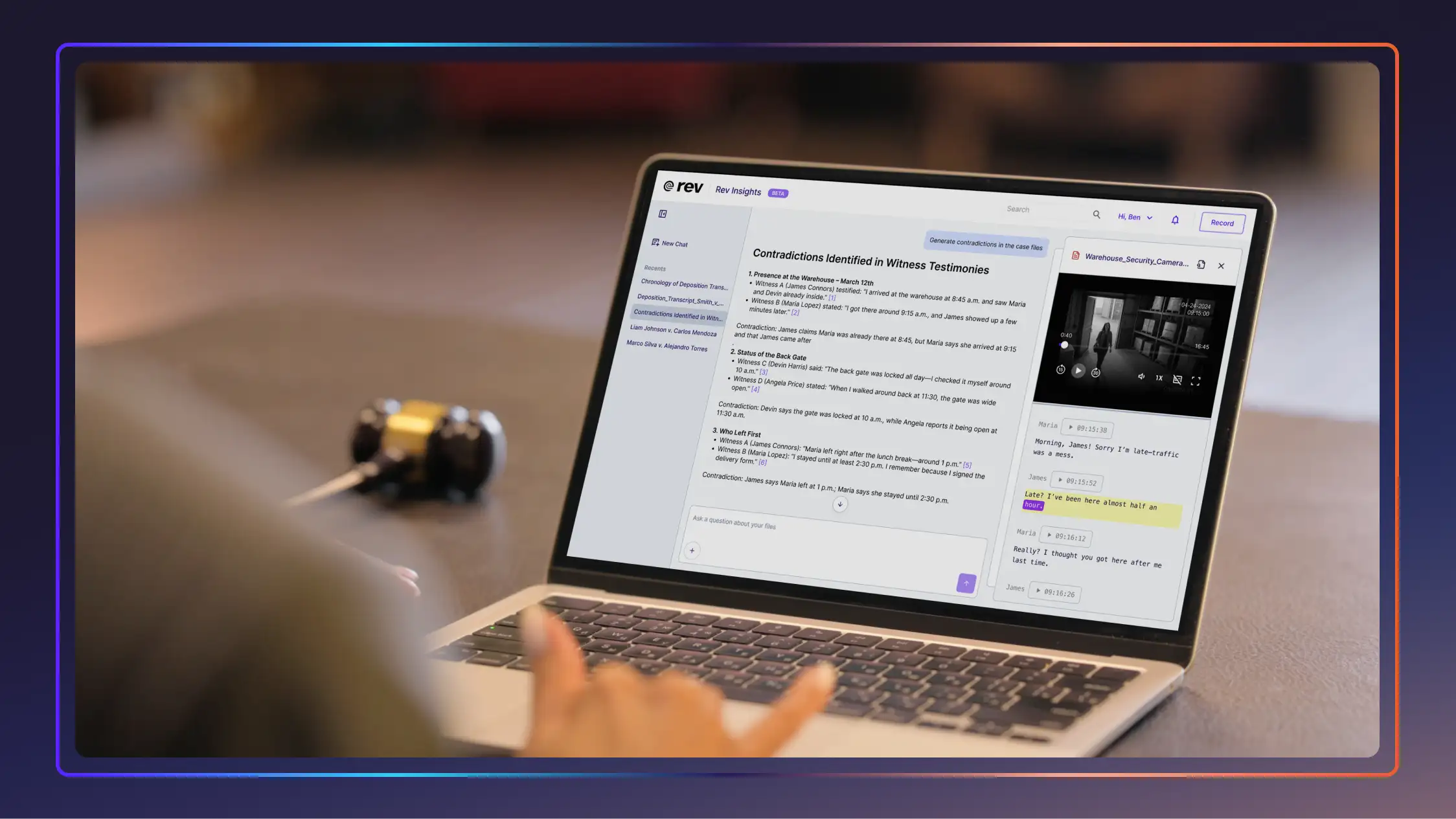How to Send Legal Documents Through the Mail Safely
Wondering how to send all your legal documents through the mail safely but can’t make heads or tails of it? Rev has you covered.

“Snail mail,” or the act of sending actual physical documents using a postal service, isn’t the most popular or efficient way to send information in today’s digital age. But when it comes to sending legal documents safely, the good ol’ United States Postal Service (USPS) might actually be your safest option.
Since legal documents often contain confidential or time-sensitive information, using a trustworthy delivery method is very important. Even the most secure digital methods can be targeted by hackers, so going old-school is often your best bet.
Rev takes security very seriously, especially when it comes to the court reporting and legal industries. That’s why we’ve put together this guide to mailing important documents.
Option 1: Registered Mail
USPS Registered Mail is the cream of the crop when it comes to mail security. It’s what people use when they’re sending high-dollar items like jewelry, cash, or money orders. Sensitive information is no different.
When a piece of Registered Mail isn’t moving along its route, it’s stored in locked, secure safes or lockboxes. Every item comes with electronic tracking, which provides a record of the item’s chain of custody that lists every USPS employee who touches the item. You can receive real-time updates of your mail’s movements as well. USPS provides $25,000 of insurance for every piece of Registered Mail, and a signature upon delivery is required as well.
Registered Mail must be sent with “proof of mailing,” which means you’ll have to take it to the dropoff point in person instead of dropping it in a collection box. At the post office, you’ll need to purchase a special Registered Mail barcode label. Another drawback is that due to the tight security, delivery times are longer than regular mail, taking up to 14 days.
Cost: Starts at $16.80 and rises with declared value (in addition to regular postage)
Insurance Coverage: Up to $25,000
Delivery Time: 10-14 days
Tracking Ability: Yes
Option 2: Certified Mail
USPS Certified Mail is your next-safest option to Registered Mail. Though the security isn’t nearly as comprehensive, you still have to drop off the item in person. It’s the same on the other end, as well; the package must be signed for at delivery.
If no one’s there to offer up a signature, the carrier will take it back to the post office, where the recipient must appear in person to pick it up. Parties on either end of the delivery are kept up to date on the delivery status at all times.
The biggest difference between Certified and Registered Mail is that Certified Mail is treated throughout the process as a regular piece of mail, as opposed to being locked up at stopping points. Certified Mail is best used for important pieces that don’t have a high dollar value. Think tax info, license plates, and legal documents.
It’s important to note that Certified Mail doesn’t automatically include insurance, and because of this, it’s also a lot cheaper than Registered Mail (usually 25% less). But it is just as fast as regular mail, arriving at its destination in less than a week.
Cost: $4.40 (in addition to regular postage)
Insurance Coverage: No
Delivery Time: Two to five days
Tracking Ability: Yes
Option 3: Priority Mail (+ Express)
If you need to get legal-size documents to their destination quickly and economically but aren’t too concerned about security, USPS Priority Mail might be the best option.
The USPS offers a number of shapes and sizes of ready-to-address Priority Mail packages, and one of those just happens to be the EP14L, which is the flat-rate legal mail envelope (perfect for most low-priority legal documents).
Priority Mail is a touch faster than Certified Mail and doesn’t require a signature upon delivery. Tracking, however, is automatic so both sender and receiver are kept up to date on the package’s status. A bonus for Priority Mail is that you don’t have to drop it off in person. Heck, you can even schedule a pickup in many locations. If you need a little more speed, Priority Express is a day or two faster than regular Priority Mail, for a higher cost.
Cost: Around $10, depending on location. Priority Express is around double the price of standard Priority.
Insurance Coverage: Up to $500 for standard Priority/ $100 for Express
Delivery Time: One to three days for standard Priority/One to two days with Priority Express
Tracking Ability: Yes
Option 4: First-Class Mail
USPS First Class mail is pretty straightforward. There’s no tracking or insurance and delivery verification isn’t an option. If sending your document with First-Class Mail, expect minimal security, but faster speeds than with standard bulk mail, which could take up to four weeks to reach a national destination compared with First Class’s one to five days.
Cost: Prices based on shape and weight
Insurance Coverage: None
Delivery Time: One to five days
Tracking Ability: No
The Importance of Legal Document Safety
Almost every legal document contains some sort of sensitive information. Social Security numbers, birth dates, bank information, driver’s license numbers; everything an identity thief needs might be right there in that manilla envelope.
For a law firm, protecting client information and confidentiality is crucial. Not only because it protects the client, but because it also protects the firm’s reputation and liability. The last thing a client needs is their social security number falling into the wrong hands. According to the Bureau of Justice Statistics, in 2021, about 23.9 million people had been victims of identity theft during the prior 12 months. All an identity thief needs these days is a tiny shred of personal information, and the next thing you know one of your clients could find themselves with a compromised bank account (or worse).
In today’s world, information is practically a currency. This is why so many data breaches happen every year — hackers know the value of selling personal information. Legal documents are rife with personal information that can be damaging if placed in the wrong hands. That’s why the best way to mail legal documents is through the USPS, due to the federal laws (like the Mail Fraud Statute, the Obstruction of Mail Statue, and others) that are in place to protect even mail sent with the most basic service.
How to Increase Security For Your Team
When mailing important documents of the legal or even non-legal variety, there are a few best practices that every legal team should follow:
- Keep a chain-of-custody record before ever turning the documents over to the USPS or other delivery service
- Make sure file cabinets or other storage for legal documents remain locked when not under supervision
- Back up your files and store those physical backups in a separate place
- When sending legal documents, make sure your team knows which mail service to use for different security levels
- Ensure that parties on either end of the delivery are aware of any tracking information
Don’t Forget About Electronic Security
Can legal notices be sent by email? Sure, they can be. It’s just not as secure as physical mail.
Electronic mail security is a whole other ball game of potential breaches compared to physical mail. Cyber attacks, malware attacks, and phishing attacks; it seems like digital files are always under attack!
Law firms, no matter how analog they might try to be, inevitably store terabytes of sensitive information digitally. Because of this, thorough cybersecurity is a must.
Almost 40% of law firms reported a security breach in the last year, according to LegalDive. Furthermore, the report found that only 26% of those surveyed believe that their firm is “very prepared” to respond to a security breach. That’s not very reassuring!
To make sure that your firm isn’t in that 26%, there are a few things you can do to protect your digital and legal files:
- Encrypt all sensitive information
- Require secure digital signatures
- Back everything up, and store it offline
- Classify all documents by level of confidentiality, and group similar levels together
- Limit access to the most sensitive data
- Have an outside firm evaluate your cybersecurity measures
Common Questions Regarding Legal Mail
If you’re still in the dark about how to mail important documents, here are a few frequently asked questions that should shed some light on the subject.
What Is the Most Secure Way To Send Documents by Mail?
The most secure way to send legal documents by mail is with USPS Registered Mail because of its thorough tracking, comprehensive chain-of-custody, and lock-and-key security at every part of the journey.
Which Is Safer: Registered or Certified Mail?
Registered Mail is far safer than Certified Mail, offering comprehensive tracking, safes and/or lockboxes at stopping points, and a detailed list of everyone who touched the piece of mail.
What Happens if No One Signs for Certified Mail?
If no one signs for certified mail, the postal worker will leave a notification that an attempt was made. No second delivery will be attempted, and the recipient will have to pick the mail up at the post office. With Certified Mail, both the sender and the recipient will receive notifications about the delivery status.
Rev Secures Your Work
At Rev, we still place client security at the top of our priority list, especially when it comes to legal transcriptions or court transcriptions.
Rev maintains compliance with both internationally recognized and industry-specific security and privacy standards, including Soc 2 Type II, GDPR, and PCI. When you work with Rev, you can trust that your data is under lock and key (metaphorically speaking) no matter what.










.webp)




